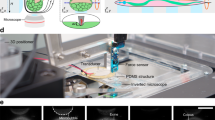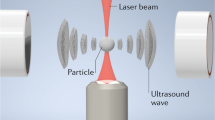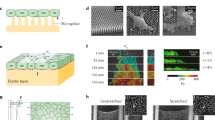Abstract
We report an atomic force microscopy (AFM) method for assessing elastic and viscous properties of soft samples at acoustic frequencies under non-contact conditions. The method can be used to measure material properties via frequency modulation and is based on hydrodynamics theory of thin gaps we developed here. A cantilever with an attached microsphere is forced to oscillate tens of nanometers above a sample. The elastic modulus and viscosity of the sample are estimated by measuring the frequency-dependence of the phase lag between the oscillating microsphere and the driving piezo at various heights above the sample. This method features an effective area of pyramidal tips used in contact AFM but with only piconewton applied forces. Using this method, we analyzed polyacrylamide gels of different stiffness and assessed graded mechanical properties of guinea pig tectorial membrane. The technique enables the study of microrheology of biological tissues that produce or detect sound.
This is a preview of subscription content, access via your institution
Access options
Subscribe to this journal
Receive 12 print issues and online access
$259.00 per year
only $21.58 per issue
Buy this article
- Purchase on Springer Link
- Instant access to full article PDF
Prices may be subject to local taxes which are calculated during checkout



Similar content being viewed by others
References
Pullarkat, P.A., Fernández, P.A. & Ott, A. Rheological properties of the eukaryotic cell cytoskeleton. Phys. Rep. 449, 29–53 (2007).
Gardel, M.L., Valentine, M.T. & Weitz, D.A. Microrheology. in Microscale Diagnostic Techniques (ed., K. Breuer) 1–50 (Springer Verlag, New York, 2005).
Ziemann, F., Rädler, J. & Sackmann, E. Local measurements of viscoelastic moduli of entangled actin networks using an oscillating magnetic bead micro-rheometer. Biophys. J. 66, 2210–2216 (1994).
Block, S.M. Making light work with optical tweezers. Nature 360, 493–495 (1992).
Ashkin, A. Forces of a single-beam gradient laser trap on a dielectric sphere in the ray optics regime. Biophys. J. 61, 569–582 (1992).
Radmacher, M., Fritz, M., Kacher, C.M., Cleveland, J.P. & Hansma, P.K. Measuring the viscoelastic properties of human platelets with the atomic force microscope. Biophys. J. 70, 556–567 (1996).
Sahin, O., Magonov, S., Su, C., Quate, C.F. & Solgaard, O. An atomic force microscope tip designed to measure time-varying nanomechanical forces. Nat. Nanotechnol. 2, 507–514 (2007).
Alcaraz, J. et al. Microrheology of human lung epithelial cells measured by atomic force microscopy. Biophys. J. 84, 2071–2079 (2003).
Hiratsuka, S. et al. The number distribution of complex shear modulus of single cells measured by atomic force microscopy. Ultramicroscopy 109, 937–941 (2009).
Higgins, M.J. et al. Frequency modulation atomic force microscopy: a dynamic measurement technique for biological systems. Nanotechnology 16, S85–S89 (2005).
Humphris, A.D.L., Tamayo, J. & Miles, M.J. Active quality factor control in liquids for force spectroscopy. Langmuir 16, 7891–7894 (2000).
Chadwick, R.S. & Liao, Z. High-Frequency oscillations of a sphere in a viscous fluid near a rigid plane. SIAM Rev. 50, 313–322 (2008).
Yeung, T. et al. Effects of substrate stiffness on cell morphology, cytoskeletal structure, and adhesion. Cell Motil. Cytoskeleton 60, 24–34 (2005).
Morse, P.M. & Ingard, K.U. Theoretical Acoustics (McGraw-Hill, New York, 1968).
Mathur, A.B., Collinsworth, A.M., Reichert, W.M., Kraus, W.E. & Truskey, G.A. Endothelial, cardiac muscle and skeletal muscle exhibit different viscous and elastic properties as determined by atomic force microscopy. J. Biomech. 34, 1545–1553 (2001).
Hertz, H. Uber die beruhrung fester elastischer korper (On the contact of elastic solids). J. Reine Angew. Math. 92, 156–171 (1881).
Hodges, C.S. Measuring forces with the AFM: polymeric surfaces in liquids. Adv. Colloid Interface Sci. 99, 13–75 (2002).
Weisenhorn, A.L., Maivald, P., Butt, H.J. & Hansma, P.K. Measuring adhesion, attraction, and repulsion between surfaces in liquids with an atomic-force microscope. Phys. Rev. B 45, 11226 (1992).
Fritz, M., Radmacher, M. & Gaub, H.E. Granula motion and membrane spreading during activation of human platelets imaged by atomic force microscopy. Biophys. J. 66, 1328–1334 (1994).
Gavara, N. & Chadwick, R.S. Collagen-based mechanical anisotropy of the tectorial membrane: implications for inter-row coupling of outer hair cell bundles. PLoS One 4, e4877 (2009).
Richter, C.P., Emadi, G., Getnick, G., Quesnel, A. & Dallos, P. Tectorial membrane stiffness gradients. Biophys. J. 93, 2265–2276 (2007).
Abnet, C.C. & Freeman, D.M. Deformations of the isolated mouse tectorial membrane produced by oscillatory forces. Hear. Res. 144, 29–46 (2000).
Ghaffari, R., Aranyosi, A.J. & Freeman, D.M. Longitudinally propagating traveling waves of the mammalian tectorial membrane. Proc. Natl. Acad. Sci. USA 104, 16510–16515 (2007).
Fabry, B. et al. Time scale and other invariants of integrative mechanical behavior in living cells. Phys. Rev. E 68, 041914 (2003).
Novak, P. et al. Nanoscale live-cell imaging using hopping probe ion conductance microscopy. Nat. Methods 6, 279–281 (2009).
Wang, Y.L., Pelham, R.J. & Richard, B.V. Preparation of a flexible, porous polyacrylamide substrate for mechanical studies of cultured cells. in Methods in Enzymology (eds., J. Abelson, R. Vallee & M. Simon) Vol. 298, 489 (Academic Press, 1998).
Butt, H.J. & Jaschke, M. Calculation of thermal noise in atomic-force microscopy. Nanotechnology 6, 1–7 (1995).
Sneddon, I.N. The relation between load and penetration in the axisymmetric Boussinesq problem for a punch of arbitrary profile. Int. J. Eng. Sci. 3, 47–57 (1965).
Acknowledgements
We thank T.B. Friedman and K.H. Iwasa for critical input. This work was supported by the Intramural Program of the US National Institute of Deafness and Other Communication Disorders.
Author information
Authors and Affiliations
Contributions
N.G. conceived, designed and performed the experiments, analyzed the data and wrote the paper. R.S.C. developed the hydrodynamic lubrication theory, conceived and designed the experiments and wrote the paper.
Corresponding author
Ethics declarations
Competing interests
The authors declare no competing financial interests.
Supplementary information
Supplementary Text and Figures
Supplementary Figures 1–4, Supplementary Table 1 and Supplementary Notes 1–3 (PDF 430 kb)
Rights and permissions
About this article
Cite this article
Gavara, N., Chadwick, R. Noncontact microrheology at acoustic frequencies using frequency-modulated atomic force microscopy. Nat Methods 7, 650–654 (2010). https://doi.org/10.1038/nmeth.1474
Received:
Accepted:
Published:
Issue Date:
DOI: https://doi.org/10.1038/nmeth.1474
This article is cited by
-
3D nanomechanical mapping of subcellular and sub-nuclear structures of living cells by multi-harmonic AFM with long-tip microcantilevers
Scientific Reports (2022)
-
Apical surface supracellular mechanical properties in polarized epithelium using noninvasive acoustic force spectroscopy
Nature Communications (2017)
-
High-frequency microrheology reveals cytoskeleton dynamics in living cells
Nature Physics (2017)
-
Combined strategies for optimal detection of the contact point in AFM force-indentation curves obtained on thin samples and adherent cells
Scientific Reports (2016)
-
Basilar Membrane and Tectorial Membrane Stiffness in the CBA/CaJ Mouse
Journal of the Association for Research in Otolaryngology (2014)



